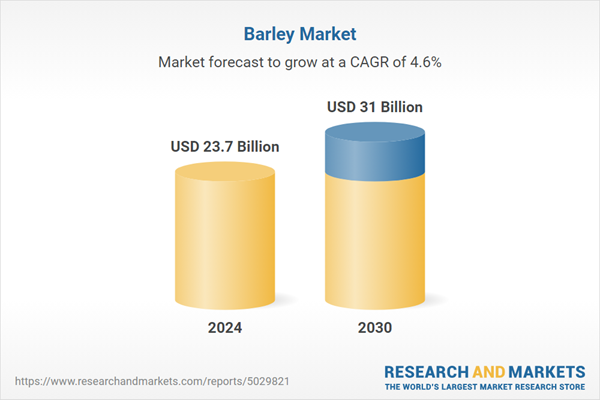The global market for Barley was valued at US$23.7 Billion in 2024 and is projected to reach US$31.0 Billion by 2030, growing at a CAGR of 4.6% from 2024 to 2030. This comprehensive report provides an in-depth analysis of market trends, drivers, and forecasts, helping you make informed business decisions.
Global Barley Market - Key Trends and Drivers Summarized
Why Is Barley Gaining Popularity in Health Foods and Beverages?
Barley is experiencing a resurgence in popularity as a key ingredient in health foods and beverages, thanks to its rich nutritional profile and versatility. This ancient grain is packed with essential nutrients, including fiber, vitamins, minerals, and antioxidants, making it an excellent choice for health-conscious consumers. Barley's high fiber content, particularly beta-glucan, is known to support heart health by lowering cholesterol levels and improving digestive health. As more consumers seek out natural and wholesome foods, barley is being increasingly incorporated into a wide range of products, from breakfast cereals and energy bars to plant-based beverages and bakery items. The grain's mild flavor and adaptability make it a popular ingredient in both traditional and modern recipes, catering to the growing demand for nutritious and functional foods.What Technological Innovations Are Enhancing Barley-Based Products?
Technological innovations are playing a crucial role in enhancing the quality and appeal of barley-based products, making them more accessible and enjoyable for consumers. Advances in food processing techniques, such as milling, extrusion, and fermentation, have improved the texture, flavor, and nutritional value of barley products. For example, the development of barley flour with finer particle size has enhanced its use in baking, resulting in softer and more palatable baked goods. Fermentation technology is also being used to produce barley-based beverages, such as non-alcoholic beers and functional drinks, that cater to the growing demand for healthier alternatives. Additionally, genetic research and breeding programs are focused on developing new barley varieties with improved nutritional profiles and resistance to environmental stresses, ensuring a consistent and high-quality supply of barley for food and beverage production. These technological advancements are driving the growth of barley-based products in the health food and beverage market.Why Is Barley Important for Sustainable Agriculture?
Barley is not only valued for its nutritional benefits but also for its role in promoting sustainable agriculture. As a resilient crop that can thrive in a variety of climates and soil conditions, barley is well-suited to sustainable farming practices. The crop's ability to grow in marginal lands with minimal water and fertilizer inputs makes it an environmentally friendly option for farmers seeking to reduce their ecological footprint. Additionally, barley's deep root system helps improve soil health by preventing erosion and enhancing water retention. The use of barley in crop rotation systems also contributes to sustainable agriculture by reducing the need for chemical inputs and supporting biodiversity. As sustainability becomes a key consideration for both consumers and producers, barley's role in sustainable agriculture is likely to enhance its appeal in the food and beverage industry.What Factors Are Accelerating the Growth of the Barley Market?
The growth in the barley market is driven by several factors, including the increasing consumer demand for health-conscious and functional foods that support overall wellness. Technological advancements in food processing and crop genetics are enhancing the appeal and availability of barley-based products, making them more accessible to a broader audience. The emphasis on sustainability in agriculture is also playing a significant role, as barley's environmental benefits align with the growing consumer preference for eco-friendly and sustainable products. Additionally, the versatility of barley as an ingredient in a wide range of food and beverage applications is expanding its market presence. As these trends continue to shape the food industry, the barley market is poised for sustained growth, supported by ongoing innovations and the rising interest in healthy, natural foods.Report Scope
The report analyzes the Barley market, presented in terms of market value (US$ Thousand). The analysis covers the key segments and geographic regions outlined below.Segments
Grade (Malt Grade, Feed Grade, Food Grade); Application (Food & Beverage, Pharmaceuticals, Nutraceuticals, Seeds).Geographic Regions/Countries
World; United States; Canada; Japan; China; Europe (France; Germany; Italy; United Kingdom; Spain; Russia; and Rest of Europe); Asia-Pacific (Australia; India; South Korea; and Rest of Asia-Pacific); Latin America (Argentina; Brazil; Mexico; and Rest of Latin America); Middle East (Iran; Israel; Saudi Arabia; United Arab Emirates; and Rest of Middle East); and Africa.Key Insights:
- Market Growth: Understand the significant growth trajectory of the Malt Grade Barley segment, which is expected to reach US$17.7 Billion by 2030 with a CAGR of a 4.9%. The Feed Grade Barley segment is also set to grow at 3.9% CAGR over the analysis period.
- Regional Analysis: Gain insights into the U.S. market, valued at $6.2 Billion in 2024, and China, forecasted to grow at an impressive 7.1% CAGR to reach $6.8 Billion by 2030. Discover growth trends in other key regions, including Japan, Canada, Germany, and the Asia-Pacific.
Report Features:
- Comprehensive Market Data: Independent analysis of annual sales and market forecasts in US$ Million from 2024 to 2030.
- In-Depth Regional Analysis: Detailed insights into key markets, including the U.S., China, Japan, Canada, Europe, Asia-Pacific, Latin America, Middle East, and Africa.
- Company Profiles: Coverage of major players such as Ackermann Saatzucht GmbH & Company KG, Agremo, AGROALIMENTARE SUD S.p.A., Agrokultura, Blue Lake Milling and more.
- Complimentary Updates: Receive free report updates for one year to keep you informed of the latest market developments.
Why You Should Buy This Report:
- Detailed Market Analysis: Access a thorough analysis of the Global Barley Market, covering all major geographic regions and market segments.
- Competitive Insights: Get an overview of the competitive landscape, including the market presence of major players across different geographies.
- Future Trends and Drivers: Understand the key trends and drivers shaping the future of the Global Barley Market.
- Actionable Insights: Benefit from actionable insights that can help you identify new revenue opportunities and make strategic business decisions.
Key Questions Answered:
- How is the Global Barley Market expected to evolve by 2030?
- What are the main drivers and restraints affecting the market?
- Which market segments will grow the most over the forecast period?
- How will market shares for different regions and segments change by 2030?
- Who are the leading players in the market, and what are their prospects?
Some of the 352 major companies featured in this Barley market report include:
- Ackermann Saatzucht GmbH & Company KG
- Agremo
- AGROALIMENTARE SUD S.p.A.
- Agrokultura
- Blue Lake Milling
- Bob's Red Mill Natural Foods
- Browning Seed Inc.
- CRASTAN S.p.A.
- Crisp Malting Group
- Global Grains & Ingredients Ltd.
Table of Contents
I. METHODOLOGYII. EXECUTIVE SUMMARY2. FOCUS ON SELECT PLAYERSIII. MARKET ANALYSISSOUTH KOREAREST OF ASIA-PACIFICARGENTINABRAZILMEXICOREST OF LATIN AMERICAIRANISRAELSAUDI ARABIAUNITED ARAB EMIRATESREST OF MIDDLE EASTIV. COMPETITION
1. MARKET OVERVIEW
3. MARKET TRENDS & DRIVERS
4. GLOBAL MARKET PERSPECTIVE
UNITED STATES
CANADA
JAPAN
CHINA
EUROPE
FRANCE
GERMANY
ITALY
UNITED KINGDOM
SPAIN
RUSSIA
REST OF EUROPE
ASIA-PACIFIC
AUSTRALIA
INDIA
LATIN AMERICA
MIDDLE EAST
AFRICA
Companies Mentioned (Partial List)
A selection of companies mentioned in this report includes, but is not limited to:
- Ackermann Saatzucht GmbH & Company KG
- Agremo
- AGROALIMENTARE SUD S.p.A.
- Agrokultura
- Blue Lake Milling
- Bob's Red Mill Natural Foods
- Browning Seed Inc.
- CRASTAN S.p.A.
- Crisp Malting Group
- Global Grains & Ingredients Ltd.
Table Information
| Report Attribute | Details |
|---|---|
| No. of Pages | 478 |
| Published | March 2025 |
| Forecast Period | 2024 - 2030 |
| Estimated Market Value ( USD | $ 23.7 Billion |
| Forecasted Market Value ( USD | $ 31 Billion |
| Compound Annual Growth Rate | 4.6% |
| Regions Covered | Global |









